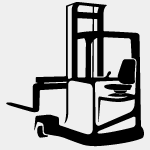Forklift encyclopedia
These types exist
- Container Handlers
- Forklifts
- Rough Terrain Forklifts
- Pallet Jacks/Free transport offer/Warehouse Equipment:
- Order Pickers:
- Warehouse Equipment/Stacking/Pallet Stackers:
- Truck Mounted Forklift
- Reachstackers
- Telehandlers
- Four-way side loader:
Container Handlers
Container handlers are specially designed for handling shipping containers on ships, trains and trucks. The biggest challenge for a container handler is handling a load while keeping its counterweight mechanism balanced. In comparison to a Reach Stacker the container handler can only stack in the first row, where a reach stacker can reach in to the third row. As such, a container handler weighs 14,000 lbs. less than a reach stacker. The weight of an empty shipping container is approximately 2,000 lbs. and fully equipped container handler has an 8,000 lbs. load capacity. Some empty container handlers are equipped with a double lift frame, enabling the lift of two empty containers at once. Container handlers are typically diesel operated, however electric models do exist.
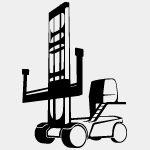
Forklifts
Forklifts are the most common type of material handling equipment, and are characterized by its lifting unit, which consist of a mast, dictating how high it can reach; and the forks, with an average span of 47 inches. Available in a wide variety of configurations, makes them ideal for transporting goods on individual pallets or stacked. For example, low noise, zero emissions electric forklifts are used mainly indoors, where LPG, diesel or gasoline forklifts are equipped with pneumatic or cushioned tires for outdoor use. In order to ensure that the 78 inch maximum reach of the mast is not exceeded, the driver’s compartment is one seat covered by a frame with a closed top. Larger forklifts, by contrast, are equipped with a cabin to protect the driver from varying weather conditions. Motors are located underneath the driver’s seat, creating stability a low center of gravity while driving or stacking. Rear-wheel steering makes front loading forklifts extremely maneuverable in narrows aisles and ideal for warehouses. Differences between three and four wheeled forklifts are few, both commonly found with electric motors and a width of three feet. The four wheeled truck is used for heavier lifting and has better stability whereas three wheeled trucks are more maneuverable. Some front loading forklifts have a 6.5 ton load capacity. Maximum load and motor type are always the deciding factors when purchasing a forklift. The height of the truck is determined by the nature of the mast. The mast can be constructed as a duplex (two stages) or triplex (three stages). This design allows the masts of front fork to lift hydraulically and extend to two or three times its original length, so that loading levels between 140 inches and 275 inches can be achieved. Wide range of attachments turns any forklift into a flexible all-rounder. More information about forklift attachments is available.
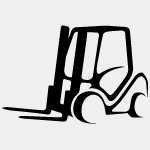
Rough Terrain Forklifts
The rough terrain forklift is a 4x4 forklift, which is designed to work outdoors or on difficult terrain. Common characteristics are optimal off-road capability and high ground clearance. Depending on work conditions there are different variations and models of rough terrain forklift. For potholes and uneven terrain, larger tires are recommended. For industrial locations, there are industrial tires, which are smoothed with better handling on asphalt or concrete surfaces. In muddy and hilly dirt environments great care should be taken to use an off-road tires with four-wheel drive. Using a rough terrain forklift as accurate as possible will ensures efficient and productive work conditions and safety for the driver. Most of the rough terrain forklifts are diesel operated, but there are also versions with LPG or gasoline. In addition, these forklifts come with four or six pneumatic tires. Rough terrain forklifts equipped with a hydrostatic transmission are common, but are also built with mechanical or hydrodynamic gear transmissions. For a higher degree of mobility, there are also rough terrain forklifts with articulating joints, differential locks with two-and four-wheel drive. A rough terrain forklift must have high stability and resistance, requiring a robust mast and mono-block chassis. The most common applications for rough terrain forklifts are brick, concrete, construction, mining, recycling and wood industries.
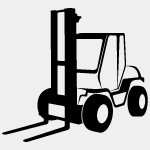
Pallet Jacks/Free transport offer/Warehouse Equipment
Whether in manufacturing and production facilities, local supermarkets or on the back of a truck, pallet jacks and order pickers are very useful. Pallet jacks are easy to use, small, and flexible and allow easy transport of pallets and other goods without tedious manual lifting. For ground-level transportation and loading of goods, there are different versions of the pallet jacks:
Electric Pallet Jacks
Typically operated by foot and available with an electric motor, pallet jacks consist of two forks, front load wheels, rear double-wheels, with handle operated by hydraulics. Goods may be loaded for transport. The average vertical reach of a pallet jack is 10 inches, with a 4000 lb. load capacity.
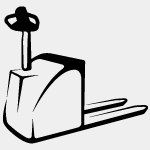
Scissor Lifts / Pallet Jacks
The scissor lift pallet jack is similar in function to a pallet jack, with the added functionality of lifting its load vertically up to 30 inches. This is achieved using, either a hand operated or electric, hydraulic pump. With a 2000 lb. load capacity, scissor lift pallet jacks are used in logistic centers to aid employees with daily lifting tasks.

Order Pickers
Order pickers or “Picker” are electric-powered industrial lifts in which the driver's seat and driving position - in contrast to conventional forklifts – is raised with working height. Order Pickers differ mainly by maxiumum vertical reach: Low Level, Medium Level and High Level order pickers.

high level order picker
The high level order picker features a vertical lift of up to 500 inches and a capacity of up to 4500 lbs. For the storage of goods, there are two different ways: manual storage and retrieval, by raising the platform to desired height then loading goods onto the platform or mechanical storage and retrieval with forks moving through the driver's seat.
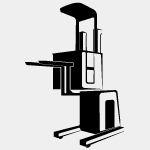
Medium Level order picker
Medium level order pickers have a can reach of up to 230 inches and have a 500 lbs load capacity.
- Popular Manufacturers of Medium Level order picker "../for-sale/horizontal-order-picker" class="link_underline">Search result for Medium Level order picker
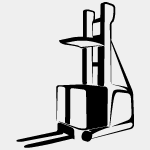
Low level order picker
Low level order picker mainly serve the storage and transporting loads up to 80 inches with a capacity of up to 6000 lbs.

Warehouse Equipment/Stacking/Pallet Stackers
Stackers are available with a manual or a mechanical lift. Manual lift is aided by a hydraulic valve which is operated by hand or foot. To allow for the smooth lowering of the load the valve is opened slowly. The hand-operated stackers have a load capacity up to 2500 lbs and a maximum lift height of up to 80 inches. The most common stackers are the electric type with a lifting capacity of up to 5000 lbs. and reaching heights of up to 216 inches. The operator walks with the stacker or can sit in the driver's cab. Reach stackers are preferred for their excellent maneuverability and ease of operation in the entire logistics industry.
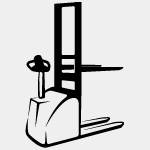
Stacker compact
Stacker differs substantially from conventional forklifts by the lack of driver's seat. The stacker is designed as a pedestrian device, while some models have a fold-out driving position. Due to the lack of driver's seat are smaller and more agile than stacker forklifts and are preferred, especially in small and cramped factories.

Stackers stand-on
The advantages of the stand on stacker- compared to a conventional drawbar unit - are an extremely small turning radius in tight spaces and increased safety and comfort for the driver.

Stacker sit on
Sit-on stackers are specifically designed for transport distances of about 300 feet and 5 hours per day. For longer transport routes and operating times, a reach truck is better suited, and is between 25 and 50 percent more expensive and often yields a better result. The small turning radius makes it a popular device in narrow halls.
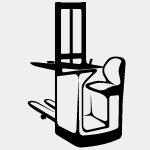
Turret Truck
Narrow aisle trucks are the perfect solution for optimal space utilization. These trucks are also used in the corridors, which are slightly wider than the truck itself, 100 percent maneuverable, and utilize less place for more storage spaces. Narrow aisle trucks usually have a capacity between 1700 lbs and 4500 lbs and a lifting height of 118 inches to over 500 inches.
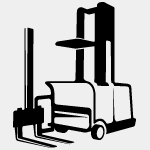
Reach Trucks
Reach trucks are designed primarily for the transport of long and bulky goods. Most models are powered by diesel or electric. The driver sits here on the side of the unit and operates from there to the mast, which is then pushed forward and lifting can be lowered to the ground. Boom is retracted and the product is inside the support arms. This way, heavy load can be transported safely and without unnecessary counterweight. Among the current models, there are also versions with a side mast. In this case the goods to be carried on the laterally extensible and stored for transporting laterally on the transport surface.
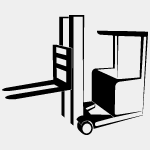
Truck Mounted Forklift
This forklift is designed in such a way that it can be transported at the rear of the truck trailer. Upon the arrival at the work place the truck can be set up in a very short period of time, so it very efficient to load and unload the goods. Compared to conventional forklift, the truck mounted forklift a much lower weight and is characterized by its good maneuverability.

Reachstackers
Just like the container handler, reach stacker is also part of the forklifts family. While the container handler can reach only up to the first row, reach stackers can carry around 100,000 lbs. with its telescopic arm and reach up in the third row and a maximum 6-fold stacked one above the other. Optimally equipped reach stacker can carry up to 200,000 lbs. Reach stacker is protected by various extensions can be used to replace expensive equipment such as gantry crane container crane.
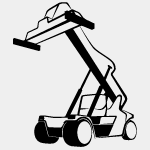
Telehandlers
The telehandler or telescopic forklifts are commonly used in the agriculture, construction, and industrial setting. With this type of forklift a lifting height up to 100 feet can achieved. With a fully swiveling truck superstructure called rotor, rotating telehandler or telescopes, the maximum load in current models can be up to 40,000 lbs. Telehandlers usually have a four-wheel-drive diesel engine with an oscillating rear axle to achieve optimal off-road capability. For flexible and efficient use in any position, the operator can select the telescopic lift truck operating modes. Telehandlers are very versatile machines due to the free attachment section at the head of the telescopic arm which allows for multiple attachments to be installed.

Four-way side loader
Four-way side loaders can be electric, diesel or gas-powered and are designed to transport long, bulky goods in a confined spaces and stack. The most common areas for 4-way side loaders are the lumber processing and where long steel or plastic pipes are moved. The four-way side loader lifts the goods with the lateral fork and places it on the so-called table - from transport - a shelf on one side of the truck side. All 4-way side loaders forklifts have a multi directional steering meaning they can rotate their 4 wheels by 90 degrees; this allows the side loader to have an extremely small turning radius and therefore can be used instead of a common side loader where the area is far too small.

Sideloaders
Side loaders can be electric, diesel or gas-powered and are designed to transport long, bulky goods in a confined space and stack. The most common areas of work for side loader is the lumber processing or in industries where long steel or plastic pipes are moved. The truck lifts the goods with the lateral fork and places it on the so-called table - from transport - a shelf on one side of the truck side. The commercial side loader has lifting capacity 2200 lbs -13000 lbs with a lift height of 118 inches to 315 inches.

Four-way reachtrucks
Especially for long loads, these devices can work sideways but can also have frontal access and can alter their direction of travel as needed. Capacity from 4000 lbs to 5000 lbs and a lift up to 315 inches.
